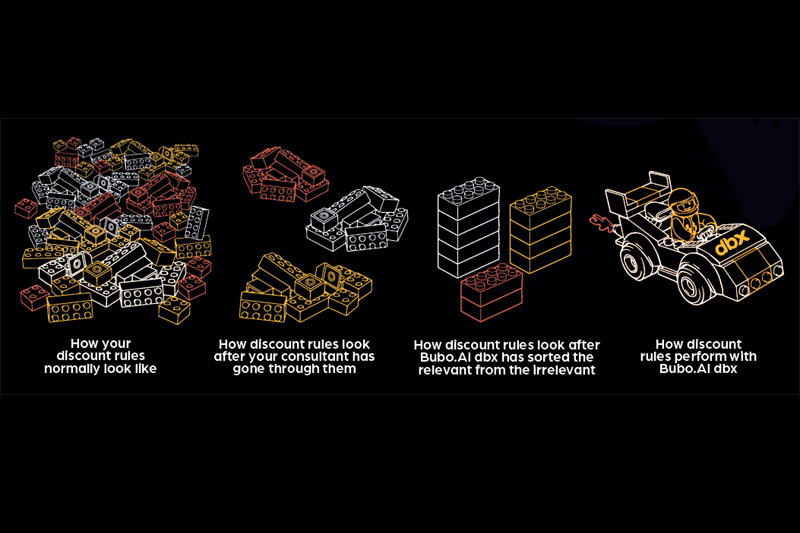
Imagine if you could increase your gross margins by 3%, or more, simply by getting control of your unmanageable discount rules. Here, Alan Timothy, CEO of Bubo.AI, looks at one way of doing it using AI technology.
Most merchants try to manage discount rules using spreadsheets. These are set by customer / group of customers and product / group of products, however these can soon become unmanageable because individual branches and salespeople keep adding in new terms and/or discounts for individual customers, coupled with overrides for single sales transactions.
One merchant we worked with had over 160,000 discount rules on their accounting system, with an additional 400-500 being added each week. The branch team was soon experiencing ‘discount rule blindness’! The issue was that they ended up with multiple discount combinations for an individual customer and didn’t know which ones to remove to reduce confusion.
We also identified that two branches were giving away 80% of their discount. It clearly wasn’t working and was costing them dearly in lost margin. The managers had tried to fix the problem many times without success, mainly because the spreadsheets were so complicated.
The situation was completely unmanageable and by the time they were able to unpick the discount terms into a sensible structure, new rules had been added.
Using the power of technology
It was against this background that we set about developing a method of tackling the problem using the processing power of AI. We worked with our scientific advisor Huseyin Seker, the leading professor in the subject at Birmingham University, along with backing from Google and Microsoft.
We start by getting three months’ worth of customer data and then carry out a free analysis that tells the merchant how much money they are leaving on the table by eliminating unfair discounts and how many redundant discount rules they have. Doing this allows us to clearly quantify how we can improve things for the merchant.
For the customer with over 160,000 discount rules, we discovered that that only 350 were actually being used. Once we’d dealt with all the others, it suddenly made them manageable and put their branches in charge of their margin once again.
The remaining discount rules are then assessed in a ‘price fairness index’. Typically, when we look at the remaining ‘active’ discount rules we find that 50% of them make the merchant a ‘good’ margin, 25% an acceptable margin and the remaining could be better (offering too much discount).
Take an example where a builder visits a merchant’s branch for their usual large order of sand, receiving their normal 15% discount for a bulk order. As they leave, they ask the price of two wheelbarrows (they don’t ‘know’ what the price of these items are, just that they will be around £50 each). They add the wheelbarrows to the same order and so receive a 15% discount on these items, too.
For the branch, that is lost margin because the customer didn’t know the ‘market’ price of a wheelbarrow as they buy them so infrequently, and so would have paid the full, undiscounted price. The fact that the branch gave 15% discount cost them £15 in lost margin (two £50 wheelbarrows x 2 = £100, less 15%). It may seem like a small amount, but when unfair discounts like this occur multiple times every day, the lost margin sums up quickly.
Another example is where a customer was a ‘large builder’ and begins to order less but still continues to receive the same bulk discounts. Our technology has been designed to spot this anomaly and alerts the branch team with a ‘suggestion’ on a PC dashboard in real time for pricing and commercial managers to act on.
‘Specials’ is another area where discount rules are an issue. We work with merchants where up to 50% of their standard products are being put through the system as specials because salespeople know that the price won’t be challenged. What they don’t realise is that the difference between selling a product as a standard and a special can be as high as 10%, which has major implications on margin.
Grasping the opportunity
We have shown that merchants can improve around a quarter of their ‘unfair’ discount rules without any changes to volume sold. The 15% discount given on the two wheelbarrows would flag up as ‘unfair’, allowing the branch to make an adjustment, meaning the £15.00 would go directly to their gross margin.
If you add the multiple tens of thousands of transactions like this throughout the year, you soon see why those branches that find an effective way of getting control of their discount rules can increase overall gross margins by 3-5%.
The choices are stark; carry on using a spreadsheet and lose out on significant margin opportunity and, at some point, have to pay a pricing consultant anywhere up to £40-50,000 to sort the discount structure out (although once the consultant has left, with no checks in place, the situation soon reverts back to what it was).
Alternatively, forward thinking merchants who embrace AI technology with its user friendly dashboard find that it brings order to their unmanageable discount rules — and keeps them that way. The result is a 3% or more increase in gross margin.
Bubo.AI supports customers such as wholesalers, retailers and other B2B companies through the use of its award-winning AI technology and expertise to determine the “optimal price point for each and every individual transaction”. The firm says it is “committed to deliver profitable growth and typically achieves a 3% increase in gross margin” for its customers.
Click here for more information about Bubo.AI’s DBX AI-powered discount management solution.









